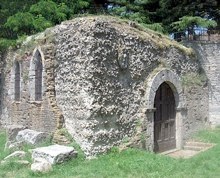


This Roman cistern was originally divided internally into two compartments. It received its portal and windows and its outer brick facing when it was converted to serve as an oratory, perhaps in the 12th century. It seems likely that the oratory was dedicated to St Cassian of Imola.
According to a postscript to the legend of St Fortunatus, which was probably written in the 12th century, he was buried within the walls of Todi in a place called Apentino, in a church dedicated to St Cassian. The 13th century chronicle entitled “Historia Tudertine Civitatis” asserted that this church was dedicated to both St Cassian and St Callistus, and was in a place called Apeantina.
According to an unreliable legend discovered in the local archives in 1597, Pope Marcellinus appointed another St Cassian as bishop of Todi during the reign of the Emperor Diocletian. He was arrested in the city and subsequently executed in “un carcer ... in modum cisternae subterraneae ... locatae in muro civitas” (in a prison in a subterranean cistern inside the city walls). It is likely that the existence of the oratory inspired the information in the legend, and that the oratory became known as the Carcere di San Cassiano only after the legend was published.
Scholars believe that the ancient church that stood on the nearby site of what is now the Cappella Gregoriana of San Fortunato was originally dedicated to St Cassian of Imola. The presumed relics of both St Cassian and St Fortunatus were certainly in this church at the time of its partial demolition in 1296. The most likely explanation is that this is where they always were, and that the oratory acquired its dedication to St Cassian when the church was rededicated to St Fortunatus.
[The Carcere has been closed for some time, but is soon to re-open and the celebration there of the feast of St Cassian each 13th August is to be revived].
Read more:
M. Castrichini et al. (eds), “Il Tempio del Santo Patrono: Riflessi Storico-Artistici del Culto di San Fortunato a Todi”, (1988) Todi contains two particularly articles relevant to St Cassian:
E. Menestò, “ ‘Nec Fortunati Tudertini Acta Silenda’: Appunti tra Storia e Agiografia”, pp 7-34
E. Paoli, “ ‘Nobile Depositum Tuderti’: Il Culto e il Tempio di San Fortunato nella Vita Religiose di Todi”, pp 35-66
Return to the Monuments of Todi.

